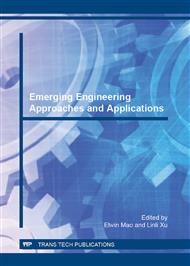[1]
Kevin Fall ,A Delay-Tolerant Network Architecture for Challenged Internets",in Proceedings of SIGCOMM, 03, Aug. (2003).
Google Scholar
[2]
Luciana Pelusi, Andrea Passarella, Marco Conti. Opportunistic Networking: Data Forwarding in Disconnected Mobile Ad hoc Networks. IEEE Communications Magazine . November (2006).
DOI: 10.1109/mcom.2006.248176
Google Scholar
[3]
A. Vahdat and D. Becker. Epidemic routing for partially connected ad hoc networks. Technical Report CS-200006, Duke University, April (2000).
Google Scholar
[4]
Fan Xiumei, Shan Zhiguang, Zhang Baoxian et al. State-of-the-art of the architecture and techniques for delay tolerant networks[J]. Chinese Journal of Electronics, 2008, 36(1): 161-170(in Chinese).
Google Scholar
[5]
Burleigh, E. Jennings, J. Schoolcraft. Autonomous Congestion Control in Delay-Tolerant Networks. In proc. of 9th International Conference on Space Operations. (2006).
Google Scholar
[6]
James A. Davis, Andrew H. Fagg, Brian N. Levine. Wearable Computers as Packet Transport Mechanisms in Highly-Partitioned Ad Hoc Networks. IEEE. 2001. 141-148.
DOI: 10.1109/iswc.2001.962117
Google Scholar
[7]
A. Lindgren and K.S. Phanse. Evaluation of queuing policies and forwarding strategies for routing in interrmittently connected networks. In Proc. of IEEE COMSWARE. January (2006).
DOI: 10.1109/comswa.2006.1665196
Google Scholar
[8]
M. Seligman, K. Fall and P. Mundur. Alternative Custodians for Congestion Control in Delay Tolerant Networks", in Proc. of ACM SIGCOMM, (2006).
DOI: 10.1145/1162654.1162660
Google Scholar
[9]
Storage Usage of Custody Transfer in Delay Tolerant Networks with Intermittent Connectivity,Matthew Seligman,(2006).
Google Scholar
[10]
Selgman. M, Fall. K, Mundur. P. Storage Routing for DTN Congestion Control. Wireless Communications and Mobile Computing, v 7, n 10, pp.1183-96, Dec. (2007).
DOI: 10.1002/wcm.521
Google Scholar
[11]
Daowen Hua, Xuehui Du, Guoyu Xu, Lifeng Cao, Huan Chen, A DTN Congestion Mechanism Based on Distributed Storage. 2010 2nd IEEE International Conference on Information Management and Engineering (ICIME 2010), pp.385-9, (2010).
DOI: 10.1109/icime.2010.5477589
Google Scholar
[12]
Juan Alonso, Kevin Fall, A Linear Programming Formulation of Flows over Time with Piecewise Constant Capacity and Transit Times. IRB-TR-03-007.
Google Scholar
[13]
A. Ker¨anen, J. Ott, and T. K¨arkk¨ainen, The one simulator for dtn protocol evaluation, in Simutools, (2009).
Google Scholar


